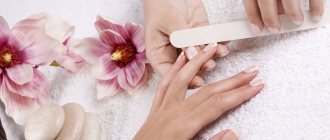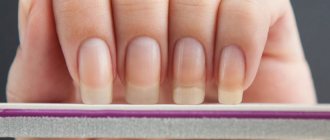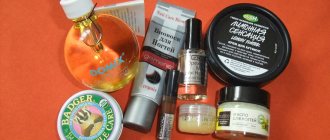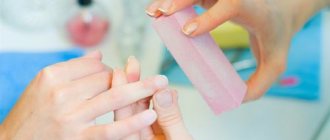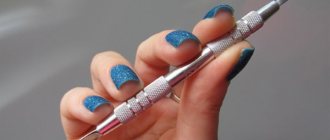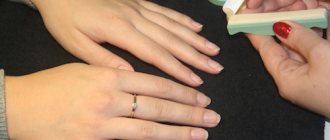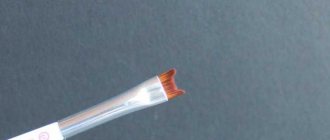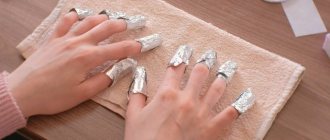Before you start working on your nails, you should choose a good file. They are not expensive at all, so you have the opportunity to experiment, choosing the most suitable one or several with different grain sizes. Don’t forget that the quality of the tool determines how easily and accurately you can process your nails. Even with good manicure technique, using a low-quality file can lead to cracking of the nail plate.
Manicure files are distinguished according to the following parameters:
- Shape (oval tool, boomerang file, block or rectangular file, banana file).
- Material (soft emery, ceramic - these are also called glass, metal).
- Functions (used for polishing, grinding, etc.).
- Abrasiveness (hardness is determined in grit - from 80 to 400 grit).
- Purpose (for nails not treated with shellac - as a rule, these can be washed; for nails strengthened with gel or shellac, acrylic).
What is abrasiveness
Files differ in their level of abrasiveness (hardness). Below are typical designations and their corresponding stiffness values:
- 80 is the toughest
- 100 - very hard
- 120 - hard
- 180 - medium hardness
- 220 - average
- 320 - softer than average
- 400 - soft
It is easy to guess that the softest files (the abrasiveness of which is 320 and 400) are mainly used for filing natural nails. The most common are double-sided abrasive tools 100/180: a hard surface designed for processing extended nails. The rough side (which has a value of 100) is convenient for removing length and leveling the surface of the nail if it is very bumpy. Using a softer surface (180 abrasiveness) we give the nails shape and smooth out minor unevenness. If you don’t know which tool you need to start with, then take 320 grit, it will be useful to you in any case. The delicate, fine-grained surface is suitable for sanding and finishing.
How to use different shaped files
Oval is used to straighten and shape nails, as well as shorten the length.
A boomerang file is convenient for straightening the edges of nails and rounding corners; it is also used for filing off gel (acrylic) in the cuticle area.
A rectangular sanding universal nail file serves the same purposes as an oval one: it is easy to shape, remove excess gel in the cuticle area and smooth the surface of the nails.
A banana nail file is especially convenient: the tool is needed to straighten nails along the edges and delicately round corners.
Home polishing of nails: sequence of actions
If you have a sterilizer, it is recommended to thoroughly disinfect all manicure tools before starting work, after which they are laid out on a towel in a convenient order.
The first block is preparation for the procedure. It includes:
- correction of the shape and length of nails;
- removing varnish with a special means;
- warm bath with 2 tsp. lemon juice and 1 tsp. sea salt.
Soft polishing is carried out with a polishing nail file with an abrasiveness of 300–350 grit.
Important: all movements must be performed carefully, in the direction of growth of the plate - that is, from the free edge to the center.
Soft grinding allows you to solve several problems at once: get rid of yellowness, level the surface of the plate, stimulate the renewal of creatine.
This is followed by the stage of primary polishing with a nail file with an abrasiveness of 600–800 grit (or the same buff).
Secondary polishing is carried out with a buff with an abrasiveness of 900–1000 grit. The procedure is carried out until the surface of the nail becomes shiny (glossy).
The last stage is applying a protective layer (varnish), treating the nails themselves and the skin around them with a softening balm.
Polishing your nails with wax
Polishing wax is the choice for those with weak, brittle, peeling nails. The procedure using this product allows you to strengthen problematic nail plates, “nourish” them with useful substances, and protect them from further destruction.
The sequence of actions is as follows:
- Cosmetic wax (paraffin) is applied to each nail;
- The product is carefully distributed over the entire plate, cuticle, and periungual ridges with gentle massage movements;
- use the rubber side of a nail polishing file to smoothly process each plate for at least 1 minute (until the fingertip slides easily over its surface);
- at the end you should soften the cuticle with a special product and cover your nails with varnish.
So, polishing is a useful procedure that can improve the appearance of fingernails and toenails and make them healthier. The procedure can be carried out in nail salons or at home. For polishing, use special files, buffs or wax. The effect of polishing is to prevent delamination, grooves and other defects, giving the nail a beautiful glossy shine. The procedure is carried out at least once every 7–14 days. For excessively brittle, thin, or very peeling nails, polishing is avoided.
What types of file materials are there: differences and descriptions
Glass is mainly suitable for filing your own (not strengthened with gel) nails. This is a modern replacement for metal, sapphire and diamond files, which have long since become obsolete, but for some reason are still advertised. The latter are inconvenient because of their small size, and also because they cause microcracks to form on the nails, causing the nails to peel. In addition, after filing they leave microscopic burrs. This can be easily checked. File your nail with a metal (diamond, sapphire) file and run it over tights or skin: you will immediately feel that the surface is not smooth, but rough.
But today laser, glass and crystal nail files are in high esteem; their popularity abroad is at its peak, although in Russia they are not yet particularly common. The peculiarity of such tools is that they “glue” the scales together, preventing the nails from delaminating. Glass, crystal and laser files can be used to work in different directions (from left to right and from top to bottom), and also to clean the inner surface of the nail.
These files can be washed, disinfected and used again and again. The only drawback of glass manicure tools is that they cannot be dropped.
Any high-quality glass, crystal, laser file has a lifetime guarantee: the good and reliable surface of the tools does not wear off.
Soft sandpaper is used for both natural and artificial nails: it all depends on the grit.
There are also cardboard nail files with varying degrees of abrasiveness (roughness). They are usually used in beauty salons. This file can only be used once; it is impractical to use.
A buff is a block with an abrasive surface on two or four sides. Buffs are needed for final leveling of the surface and removal of small grooves; the tool is also suitable for polishing. If the nail plate is not perfectly flat, for example, after removing the gel after extensions, it should be sanded with a harder base. On smooth nails, just walk over the soft surface of the buff several times.
The polisher is used to strengthen nails using special oil. This is the final stage of processing before painting with varnish.
Recommended articles on this topic:
- Shellac, manicure and pedicure for the entire vacation! How to do it yourself?
- How to strengthen your nails in 10 days?
- Review of cuticle nippers from a specialist
- How to restore nails after extensions or what is a Pi-Shine manicure?
The abrasiveness of nail files and the meaning of the number on the tool
Let us repeat that the abrasiveness of nail files is their hardness, the degree of which is expressed in grits. If you carefully examine the instrument, you will notice numbers on almost every copy, for example: 180/240, 80/100, etc. What are these values?
If you see the numbers 180/240 on your file, this means that on one side of the tool there are 180 abrasive particles for every square centimeter of the working surface, and on the other there will be 240 of them in a similar area.
Depending on the abrasiveness of nail files, all tools are divided into several groups:
- 60–80 grit. These files are the toughest. They can be used exclusively for correcting the length of artificial nails. It is impossible to process natural nail plates with such a tool, as this can lead to serious damage to the nails and their delamination.
- 100–150 grit. This file gives the desired shape to artificial nails. If the file has the inscription 100/150, then one of the sides of the tool is characterized by an abrasiveness level of 100, the other - 150.
- 150–240 grit. A tool with this level of abrasiveness is called medium hard, but it is also recommended to use it only for artificial nails. With its help, they are given their final shape and all irregularities are filed down. Such a tool can damage natural nails.
- 240 grit A file with this abrasiveness rating can be used for processing natural nail plates.
- 240–400 grit . This nail file is considered quite soft; it can be used to correct the shape of any nails and polish them.
- 400–900 grit. This file can be used on any nails to prepare them for polishing.
- 900–1200 grit. Files with this level of abrasiveness include soft buffs and microabrasives; they are used for polishing, as a result of which the nail plates acquire a mirror-like shine.
Some additional information about laser, crystal and glass files
If you prefer a European manicure, then it is most convenient and correct to do it with laser files. They can be used to file away roughened side ridges. Professional instruments with the same abrasiveness are made for pedicures, treatment of corns and calluses. In general, this is the most convenient device for European manicure.
The surface on a laser file looks like a pattern on a metal one, but the grain size is so fine and comfortable that using the tool is a pleasure.
You can do the same experiment as with a metal file: run your treated nails over tights or skin. There won't be a single clue left. It is easy to smooth out and remove roughness and unevenness with a file.
The more often you use a laser file, the sooner the need for trimmed manicure will disappear: the skin gets used to the treatment, grows slower and more evenly. The file can be used to process both skin and nails.
Many customers leave their positive reviews after using glass, crystal and laser files. Try it too. This might be the tool you've been looking for.
What else do you need to know about nail files?
It is important to remember that overgrown nails are not cut off with scissors or nippers, but only filed down. This will avoid microcracks and protect the edge of the nail from delamination.
In salons, to speed up the manicure procedure, the nail is actually first cut with clippers and then filed. This is only done if the nail is very long and filing will take a lot of time. The master processes the remaining length with a file. But if you are caring for your hands at home, it is better not to cut off the length at all, but to file off the edge of the plate without damaging it.
If your nails are thin, take a file of medium hardness, if they are hard and dense, you can choose a harder one. Please note that files from 220 grit and above are suitable for your own nails (not strengthened with gel or acrylic).
It is important to purchase only products from certified manufacturers: today there are many instruments on sale that are made using artisanal methods. Such products can cause serious harm to your nails and are generally dangerous to your health.
How to protect your nails from splitting and thinning
The choice of file determines whether your nails will be healthy. But it's not just about the chosen tool.
Few people know that the nail plate peels due to improper protection from aggressive household chemicals. You wash your hair, use various chemicals, all of this ends up under the free edge of the nail. When nails are protected from all sides, this affects beauty and health. Therefore, after treatment, you should use a base for the varnish, and you need to treat not only the surface of the nail plate, but also the free lower part.
Don't forget to cover your nails with special oils, rubbing such products into the nail itself and the cuticle. Some time will pass and you will not recognize your nails - they will become so healthy and beautiful.
In our Manicure Shop you will find the best types of modern manicure tools. All products are high quality and manufactured by reputable manufacturers. We are constantly expanding our range and will be glad if you like our products.
How to polish your nails with buff
A buff for polishing nails is used almost in the same way as a regular file, but it has its own nuances. In order not to harm the nail plate and achieve the desired results, use the buff correctly:
- Apply the working surface of the grinder to the nail plate with the wide side to cover the largest possible surface.
- During processing, make as few movements as possible.
- The nail polishing file is not intended to be used every day, so it is advisable to use it no more than once a week.
- After polishing, professionals advise to “seal” the nails so that they do not peel off. To do this, drop any essential oil onto the nail plate, then work with the softest side of the sander.
- Waxing
- How to cook pea porridge
- Your driver's license and PTS will soon look different
